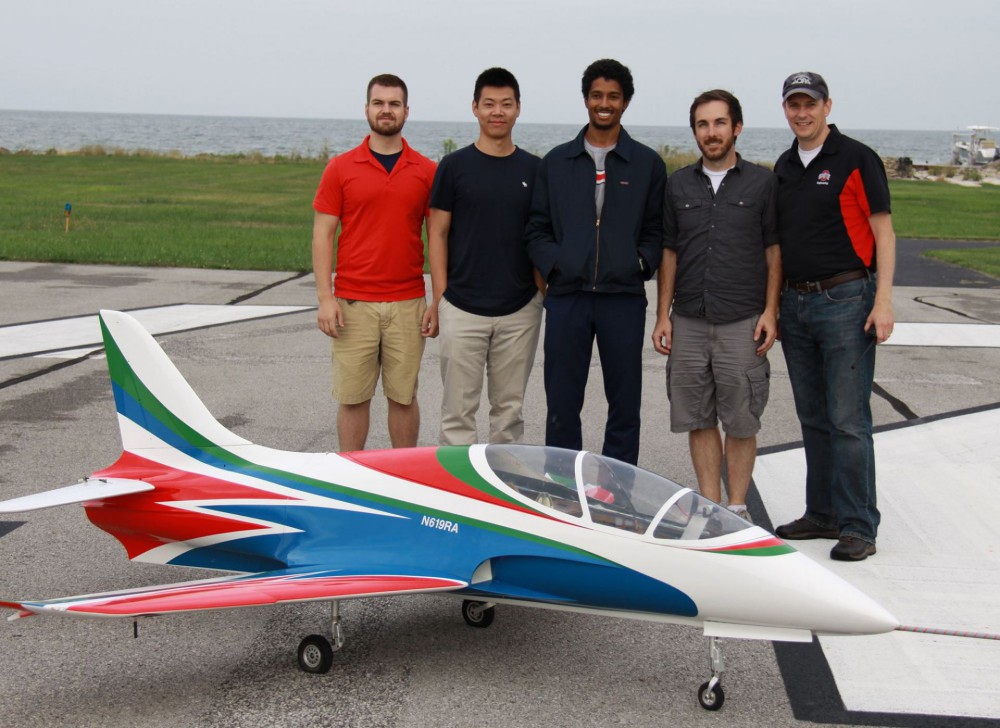 Jim Gregory was confident his team of Ohio State engineers would set the world speed record for an unmanned aerial vehicle of any size. After all, there was no record on the books. The first thing they needed to do, though, was make sure their UAV completed its route.
Jim Gregory was confident his team of Ohio State engineers would set the world speed record for an unmanned aerial vehicle of any size. After all, there was no record on the books. The first thing they needed to do, though, was make sure their UAV completed its route.
“That’s actually the hardest part here,” said Gregory, a mechanical and aerospace engineering professor and co-lead on the project.
On Aug. 30, the UAV, built at Ohio State’s Aerospace Research Center, autonomously flew a 28-mile course over Lake Erie sustaining an average speed of 147 mph for 17 minutes.
This UAV is the first step in creating what could be new possibilities in the realm package delivery and search-and-rescue missions.
“This UAV is pushing technology towards successfully flying these types of missions in our United States, which is very congested and highly dynamic,” Gregory said. “There are many technical challenges.”
Some of these challenges are being addressed with this world-record-setting flight, Gregory said. The most prominent challenge was keeping the vehicle from colliding with its surroundings.
Gregory said the project took about two years to complete and had the help from five to 10 different Ohio State students at various points.
The record-setting UAV was specially equipped to complete the mission, Gregory said. It was fitted with a custom-built flight controller, long-range fuel tanks and redundant radio control links, which would act as a failsafe should satelite communication halt. All three items were built at Ohio State.
Not every part of the UAV was built at Ohio State, however. The aircraft was also equipped with flight control via satellite communications provided by Ligado, a satellite communications company, and a device to help avoid collisions with other aircraft provided by uAvionix.
“All of the internal systems were all things developed by us or integrated in with collaboration with commercial partners,” Gregory said.
The team also had many technical hurdles to compete with during the flight including fuel limits, maintaining positive vehicle control and collision avoidance.
Detecting and solving these problems was no small task, said Matt McCrink, a research scientist at Ohio State’s Aerospace Research Center.
“We did around 15 or 20 actual flight tests and just shy of 1,000 ground-based simulations,” McCrink said.
The ground-based tests aren’t like a simulator on your computer either, McCrink said. All the UAV’s sensors are tricked and made to believe it is flying to test all the possible hardware failures during flight.
“Through these tests, we developed confidence in the system without actually having to fly it,” McCrink said.
McCrink stressed how important safety was for the project and in setting the record, which is pending review by two governing bodies for official certification. Safety is a requirement to allow the technology in this UAV to be applied for practical use in the future.
“It is one thing to go out and build and fly an airplane fast,” McCrink said. “It is another to do it safely.”

First of all, Go Bucks! However, just because a world record wasn’t recorded “in the books”, the fact remains that faster speeds have been recorded. Lastly, it appears the model looks a lot like the Hanchette brothers’ experimental aircraft called the ViperJet. Can any comment?
Global Hawk speed ~400MPH
How is this news?
“…Global Hawk speed ~400MPH – How is this news?”
Perhaps because it’s not a military aircraft and perhaps the article author should have made that distinction?